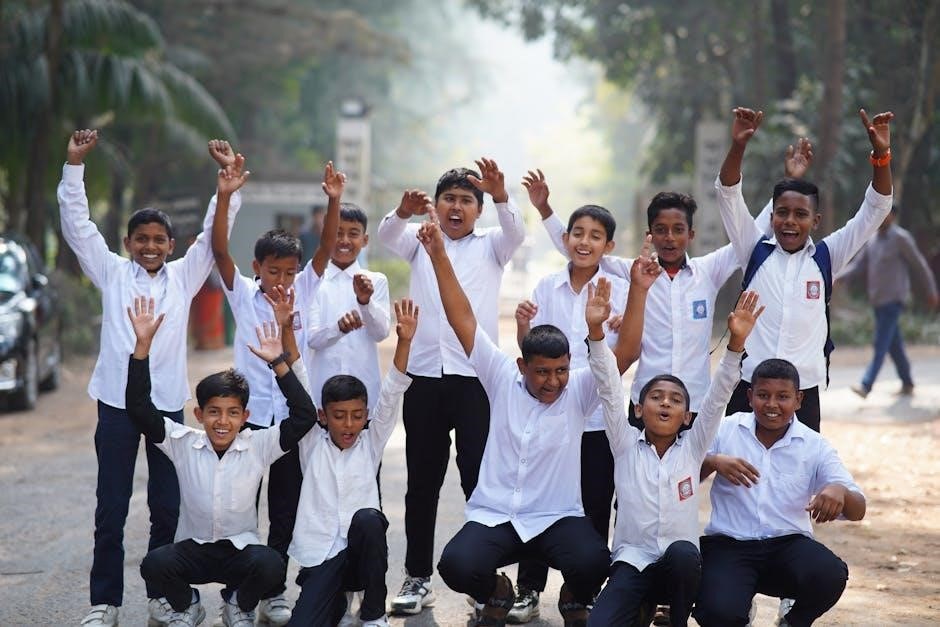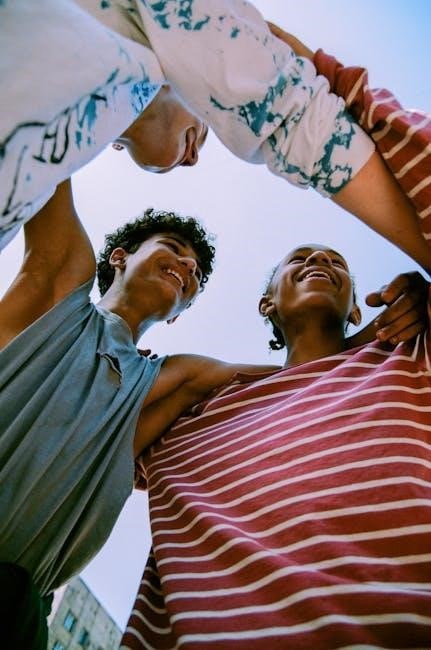
The Boys comic series, created by Garth Ennis and Darick Robertson, is a gritty, satirical exploration of a world where superheroes are corrupt and self-serving.
First published in 2006, the comic offers a dark, subversive take on the superhero genre, blending humor, violence, and moral ambiguity to critique power and societal idolization.
Its controversial themes and raw storytelling have made it a cult classic, appealing to readers seeking a bold alternative to traditional superhero narratives.
The series follows a group of vigilantes known as “The Boys” as they confront “The Seven,” a team of corrupt superheroes controlled by a powerful corporation.
With its unflinching tone and complex characters, The Boys comic has gained a dedicated fanbase and inspired a popular TV adaptation, further cementing its cultural impact.
1.1 Overview of the Comic Series
The Boys comic series, launched in 2006, spans 72 issues, blending dark humor, satire, and intense action. It follows a world where superheroes, known as “supes,” are corrupted by power and exploited by corporations. The story centers on Billy Butcher and his team, The Boys, who wage war against these corrupt heroes. The series is known for its subversive take on the superhero genre, offering a gritty, unapologetic narrative that critiques societal idolization of power. With its bold storytelling and Darick Robertson’s striking artwork, The Boys has become a cult classic, appealing to readers seeking a raw, unconventional comic experience.
1.2 Key Themes and Tone
The Boys comic explores themes of power corruption, morality, and societal critique through a dark, satirical lens. It challenges the glorification of superheroes, depicting them as flawed and self-serving. The tone is gritty and subversive, blending humor with graphic violence to highlight ethical dilemmas. The series questions authority and examines the consequences of unchecked power, offering a bold, unapologetic commentary on modern culture.

Background and Creation of The Boys
The Boys comic was created by writer Garth Ennis and artist Darick Robertson, first published in 2006 by WildStorm Productions, later moving to Dynamite Entertainment, blending dark humor and anti-superhero themes.
2.1 The Creators: Garth Ennis and Darick Robertson
Garth Ennis, a renowned comic writer known for Preacher, and Darick Robertson, an acclaimed artist, collaborated to create The Boys. Their partnership brought a unique blend of dark humor, gritty storytelling, and subversive themes to the series. Ennis’s sharp wit and Robertson’s detailed visuals crafted a compelling narrative that critiques superhero culture, making their work a standout in the genre.
2.2 Publication History and Evolution
The Boys was first published in 2006 by WildStorm, an imprint of DC Comics, but due to its explicit content, it transitioned to Dynamite Entertainment in 2007. The series concluded in 2012 with 72 issues, leaving a lasting impact on the comic industry. Its success led to a popular TV adaptation, further boosting its popularity. The comic’s availability in PDF format has made it accessible to a broader audience, ensuring its enduring influence.

Main Characters in The Boys Comic
Billy Butcher leads The Boys, a ragtag group of vigilantes targeting corrupt superheroes. Hughie Campbell joins after a personal tragedy, seeking revenge and redemption. The Boys are united by their mission to expose the truth behind the superhero facade, clashing with The Seven, a powerful team of flawed, self-serving heroes. Their dynamic drives the comic’s gritty narrative.
3.1 Billy Butcher: The Leader
Billy Butcher is the uncompromising leader of The Boys, driven by a deep-seated hatred for superheroes. His raw, brutal methods mask a calculating mind, making him a formidable strategist. Originating from London, Billy’s Cockney accent and sharp wit add depth to his character. His leadership is both charismatic and ruthless, fueling The Boys’ mission to dismantle the corrupt superhero regime, The Seven; His unwavering resolve makes him the heart of the group, balancing humor with a steely determination. Billy’s complexity lies in his ability to inspire loyalty while making morally ambiguous decisions, solidifying his role as the driving force behind The Boys’ rebellion.
3.2 Hughie Campbell: The New Recruit
Hughie Campbell is the relatable, idealistic newcomer to The Boys, joining after a tragic loss. His fresh perspective contrasts with the group’s cynicism, making him a moral compass. Hughie’s journey explores naivety, growth, and the harsh realities of fighting corrupt superheroes. His humor and empathy balance the team’s brutality, while his personal vendetta fuels his determination to challenge the system.
3.4 The Seven: Superheroes as Antagonists
The Seven are a corrupt superhero team managed by Vought International, embodying the dark side of power and celebrity culture. Led by the ruthless Homelander, they exploit their status for personal gain, manipulating public perception. Their actions highlight the dangers of unchecked authority, serving as both antagonists and a critique of societal idolization. The team’s internal conflicts further reveal their moral decay.
Key Themes in The Boys Comic
The Boys explores themes of power corruption, moral ambiguity, and societal manipulation, critiquing superhero culture and the exploitation of heroism for corporate gain and personal agendas.
4.1 Satire and Critique of Superhero Culture
The Boys comic uses biting satire to dismantle the idolization of superheroes, portraying them as self-serving, corrupt, and often more dangerous than the villains they claim to fight. Through dark humor and absurdity, the series critiques the commodification of heroism and the systemic abuse of power, challenging readers to question the morality of unchecked authority. Its bold approach sparks critical reflection on societal idolization and corporate exploitation.
4.2 Morality and Ethical Dilemmas
The Boys comic explores complex moralities, blurring the line between heroism and villainy. Characters operate in a gray ethical landscape, often committing acts of violence and manipulation. The series questions whether ends justify means, challenging readers to confront the ambiguity of morality. It portrays a world where power corrupts, forcing characters to grapple with their humanity and the consequences of their choices.
4.3 The Corruption of Power
The Boys comic delves into how power corrupts even the most well-intentioned individuals. Superheroes, backed by corporate interests, abuse their abilities for personal gain and control. The narrative highlights systemic corruption, where power fosters greed and exploitation. This theme is central to the series, showcasing the dangers of unchecked authority and its impact on individuals and society, questioning the true motives of those in power.

The Boys vs. The TV Show Adaptation
The Boys comic and its TV adaptation diverge significantly in storytelling, with the show expanding on characters and plotlines while maintaining the comic’s core themes of power and corruption.
5.1 Differences in Storylines and Character Development
The comic and show differ significantly in pacing and character depth. The TV series expands on characters like Homelander and A-Train, giving them more backstory and complexity.
Storylines are also altered, with the show introducing new arcs such as “Herogasm” and exploring themes like corporate greed and superhero culture more extensively than the comic.
5.2 How the Comic Influenced the Show
The Boys comic served as the foundation for the TV series, with its dark humor, subversive themes, and anti-superhero stance directly influencing the show’s tone and narrative.
Key characters like Billy Butcher and Homelander were adapted faithfully, maintaining their core traits and relationships.
The comic’s critique of superhero culture and corporate greed inspired the show’s exploration of these themes, though the series expanded on them with original storylines.
The Popularity and Cultural Impact
The Boys comic has redefined the superhero genre, sparking debates and gaining a cult following for its raw, unfiltered critique of power and societal norms.
6.1 Fan Reactions and Reviews
Fans of The Boys comic have praised its bold storytelling and unapologetic critique of superhero culture, resonating deeply with readers seeking a fresh, edgy narrative. Reviews highlight its ability to blend dark humor with profound commentary, making it a standout in the genre. The series’ raw and unfiltered approach has fostered a passionate fanbase, sparking intense discussions and debates about its themes and character development.
6.2 The Comic’s Legacy in the Genre
The Boys has left a lasting impact on the comic book genre, redefining how superhero stories are told by challenging conventional narratives. Its bold satire and unflinching critique of power have inspired creators to explore darker, more subversive themes. The comic’s influence is evident in its ability to spark debates and its successful adaptation into a popular TV series, cementing its place as a groundbreaking work in modern comic history.

The Boys Comic in PDF Format
The Boys comic series is widely available in PDF format, offering fans a convenient way to read and collect the entire series digitally. Platforms like Comixology and official publishers provide legal access, ensuring high-quality readability and supporting creators. This format has made the comic more accessible globally, appealing to both new and dedicated readers.
7.1 Availability and Platforms
The Boys comic series in PDF format is widely available on platforms like Comixology, Amazon Kindle, and official publisher websites, ensuring easy digital access for fans worldwide. These platforms offer high-quality formats, allowing readers to enjoy the series on various devices. Legal purchases through these sites support creators and provide readers with a seamless, convenient reading experience.
7.2 Legal and Ethical Considerations of Digital Distribution
Digital distribution of The Boys comic in PDF format raises legal concerns, as unauthorized sharing violates copyright laws. Platforms like Comixology and Kindle ensure legal access, supporting creators. Ethically, fans are encouraged to purchase copies to respect intellectual property. Piracy undermines the comic’s industry, while legal purchases promote sustainability and fairness for authors and publishers.
Collecting The Boys Comic Series
Collecting The Boys comic series, including rare PDF editions, has become highly sought after by enthusiasts, offering significant value for dedicated collectors and fans of the series.
8.1 Rare Editions and Collectibles
Rare editions of The Boys comic series, including limited first prints and variant covers, are highly sought after by collectors, offering unique artwork and exclusive content.
Collectibles like signed copies, original sketches, and special merchandise further enhance the series’ appeal, making them valuable additions for fans and investors alike.
8.2 Tips for Building a Complete Collection
To build a complete collection of The Boys comic series, start by identifying essential issues and variants, ensuring each is in good condition by checking issue numbers and quality.
Consider purchasing volumes or digital PDFs for convenience and accessibility, while tracking rare or hard-to-find issues to complete your set.
Use price guides or collector forums to determine value and authenticity, and store your collection in acid-free materials to preserve it for years to come.
The Art and Illustrations
Darick Robertson’s artistic style in The Boys comic is gritty and detailed, perfectly capturing the series’ dark tone and themes. His visuals complement the narrative, enhancing the storytelling and emotional impact.
9.1 Darick Robertson’s Artistic Style
Darick Robertson’s artwork in The Boys is known for its gritty realism and meticulous detail, perfectly capturing the comic’s dark, subversive tone. His dynamic panel layouts and character designs emphasize the brutal nature of the story, while his ability to convey emotion through facial expressions adds depth to the narrative. Robertson’s style is both raw and refined, making the series visually compelling and unforgettable.
9.2 Visual Storytelling and Symbolism
Darick Robertson’s visuals in The Boys are rich in symbolism, using imagery to convey themes of corruption, power, and societal decay. The artwork often employs stark contrasts and unsettling visuals to emphasize the moral ambiguity of the characters. Symbolism is woven into character designs, settings, and action sequences, creating a layered narrative that complements the story’s satirical tone and reinforces its critique of hero culture.
The Boys Comic and Its Audience
The Boys comic appeals to mature readers drawn to its dark humor, satire, and subversion of superhero tropes, resonating with fans seeking a bold, unconventional narrative.
10.1 Target Audience and Demographics
The Boys comic primarily targets mature audiences, particularly adults aged 18-45, drawn to its dark humor, satire, and subversion of superhero tropes. Its graphic content and complex themes appeal to readers seeking a bold, unconventional narrative. The series resonates with fans of deconstructed superhero stories, attracting a diverse demographic, including both male and female readers who appreciate its gritty, morally ambiguous storytelling.
10.2 Reader Engagement and Discussions
Readers of The Boys comic actively engage in discussions, analyzing its subversive themes and complex characters. Online forums and social media platforms host debates about the series’ critique of power and morality. Fan theories and interpretations of plot twists are common, with readers drawn to its unflinching narrative style. The comic’s controversial elements fuel lively conversations, making it a focal point in pop culture discourse and fandom communities.
The Comic’s Influence on Other Media
The Boys comic has significantly influenced other media, inspiring darker, more subversive storytelling in TV and film. Its success paved the way for edgy adaptations.
The series’ critical acclaim and originality have motivated creators to explore similar themes of power corruption and societal critique in their work.
11.1 Impact on the Superhero Genre
The Boys comic has reshaped the superhero genre by challenging traditional narratives, offering a bleak, satirical view of power and heroism. Its influence is evident in media that now often incorporates darker, more cynical themes, encouraging creators to question and subvert typical superhero tropes. This shift reflects a broader cultural appetite for complex, morally ambiguous storytelling.
11.2 Inspiration for Other Creators
The Boys comic has inspired creators across media, offering a fresh, subversive perspective on heroism and power. Its bold satire and complex characters have influenced writers, artists, and filmmakers, encouraging them to explore darker, more morally ambiguous themes. The series’ success has sparked a wave of similar narratives, reshaping how stories about heroes and villains are told.

Controversies and Criticisms
The Boys comic has faced criticism for its graphic violence, explicit content, and unapologetic satire, which some argue pushes boundaries too far, sparking debates on its intent and impact.
12.1 Criticism of Violence and Explicit Content
The Boys comic has been criticized for its graphic violence and explicit content, with some arguing it crosses ethical boundaries. Scenes of brutal gore and sexual themes have sparked debates about artistic intent versus gratuitous shock value. Critics question whether the extreme depictions serve the narrative or merely provoke. This has led to polarized opinions on the comic’s approach to satire and storytelling.
12.2 Debates Over Satirical Elements
The Boys comic’s satirical elements have sparked debate, with some praising its bold critique of superhero culture and corporate power, while others find it overly cynical or heavy-handed. Critics argue that its irreverent humor and dark themes occasionally overshadow deeper commentary, while supporters believe it effectively challenges societal norms. The series’ ability to provoke thought has led to polarized reactions, reflecting its intended subversive nature.

The Future of The Boys Comic
The Boys comic’s future hints at exciting possibilities, with rumors of spin-offs and new storylines. Fans eagerly anticipate fresh perspectives and continued satire, ensuring its legacy endures.
13.1 Upcoming Spin-offs and Sequels
The Boys comic series is expected to expand its universe with upcoming spin-offs and sequels. Fans are eagerly anticipating new storylines that delve deeper into secondary characters and explore uncharted territories within the gritty world of The Boys. These additions promise to maintain the series’ signature dark humor and satirical edge, further enriching its already compelling narrative. The future looks bright for this beloved comic franchise.
13.2 Fan Theories and Speculations
Fans of The Boys comic series are actively speculating about future storylines, with theories ranging from new character introductions to unexpected alliances. Many believe unexplored plot threads will surface, while others predict shocking twists that could redefine the series. These theories highlight the comic’s engaging narrative and its ability to inspire creative thinking among readers, keeping the community buzzing with anticipation for what’s next. The Boys’ dedicated fanbase continues to fuel vibrant discussions, showcasing the series’ lasting impact and the depth of its lore.
The Boys Comic and Digital Platforms
Digital platforms have significantly boosted the popularity of The Boys comic, offering easy access to PDF formats and fostering a global fanbase. However, piracy remains a challenge.
14.1 The Role of Digital Platforms in Popularizing the Comic
Digital platforms have played a pivotal role in popularizing The Boys comic, enabling global accessibility to its PDF format. Online stores like Amazon and Comixology have made it easier for fans to purchase and download issues, reaching a broader audience. Social media and forums have also fueled discussions, fostering a community that celebrates the series’ bold narrative and satirical themes, enhancing its cultural impact significantly.
14.2 Challenges of Digital Piracy
Digital piracy poses significant challenges for The Boys comic, with PDF versions often circulated illegally online. This unauthorized distribution violates copyright laws, depriving creators of rightful revenue. While it broadens accessibility, piracy undermines the comic’s industry, discouraging investment in new content. Fans must balance convenience with ethical support for creators to ensure the series’ sustainable future and continued innovation in storytelling and artistry.

The Boys Comic and Fandom
Fans of The Boys comic actively engage through fan art, fiction, and discussions, showcasing their creativity and passion for the series’ bold themes and characters.
15.1 Fan Art and Fan Fiction
Fans of The Boys comic express their creativity through vibrant fan art and engaging fan fiction, inspired by the series’ bold characters and themes. Digital platforms host a variety of artistic interpretations, from illustrations of Billy Butcher to reimagined storylines featuring The Seven. Fan fiction often explores alternate universes, delving into moral dilemmas and character relationships, showcasing the fandom’s deep connection to the narrative.
The TV adaptation has further fueled fan creativity, with fans blending comic and show elements in their work. This vibrant community reflects the series’ enduring appeal and its ability to inspire imaginative storytelling and artistic expression among its enthusiasts.
15.2 Community Events and Discussions
The Boys comic fosters a vibrant community of fans who engage in lively discussions and events, both online and offline. Fans share theories, analyze plot twists, and debate character motivations, creating a dynamic exchange of ideas. Digital platforms like Reddit and Discord host dedicated forums where enthusiasts explore the series’ themes and implications, further deepening their connection to the narrative and its characters.
Community events, such as comic-cons and virtual meetups, provide spaces for fans to celebrate their shared passion, often featuring fan art showcases and panel discussions. The adaptation into a TV show has further fueled these interactions, drawing new fans into the fold and inspiring fresh perspectives on the original comic series.
The Boys comic series leaves a lasting impact with its bold narrative, blending satire and drama to critique power and societal norms, ensuring its cultural relevance and enduring appeal.
16.1 Final Thoughts on The Boys Comic
The Boys comic series is a provocative, unapologetic critique of power, corruption, and societal idolization, delivered through its raw storytelling and morally complex characters. Its exploration of themes like vigilantism and corporate control resonates deeply, making it a standout in the comic genre. The series’ ability to balance dark humor with intense drama ensures its lasting relevance and appeal to readers seeking bold narratives.
16.2 The Lasting Appeal of the Series
The Boys comic series endures due to its bold satire, DARK humor, and unflinching critique of power and corruption. Its ability to challenge traditional superhero narratives while delivering complex characters and morally ambiguous themes resonates with readers seeking something provocative and thought-provoking. The series’ raw storytelling and cultural relevance ensure its continued influence and loyal fanbase, solidifying its place in the comic genre.
Leave a Reply
You must be logged in to post a comment.